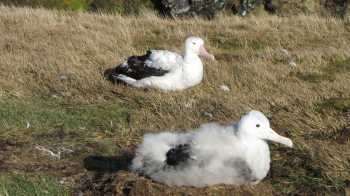Christophe Barbraud and Henri Weimerskirch of the Centre d'Etudes Biologiques de Chizé (CEBC) in France writing in the Journal of Ornithology have looked at survival and breeding interval in the normally biennial-breeding Wandering Albatross Diomedea exulans.
The paper's abstract follows:
"Estimating the effects of environmental factors on the population dynamics of albatrosses is necessary for their conservation. This requires estimation of demographic parameters, long-time series of capture-recapture data, and knowledge of their at-sea distribution. For biennial albatrosses, multistate mark-recapture models (MSMR) considering individuals during their sabbatical year as unobservable could provide reliable estimates. However, this requires that state assignment is determined with certainty which may not be the case in historical data. We applied multievent mark-recapture models (MEMR) to data on adult Wandering Albatross (Diomedea exulans) at Possession Island collected between 1966 and 2006. The models accounted for state uncertainty for those breeding states where the breeding outcome was uncertain. Survival estimates obtained from models not accounting for temporary emigration were higher than those obtained from models accounting for temporary emigration. For males and females, survival estimates from the MEMR models were higher than those from CJS and MSMR models. Annual survival probability was 0.924 (SE = 0.034) for breeding females, 0.971 (SE = 0.038) for non-breeding females, 0.954 (SE = 0.018) for breeding males, and 0.938 (SE = 0.017) for non-breeding males. Whereas Wandering Albatrosses are generally considered as obligate biennial breeders, we found that the probability that successful breeders attempted to breed in a subsequent year was 0.069 for females and 0.048 for males, although their probability of success was 44-62% lower than that of individuals that skipped breeding."
Reference:
Barbraud, C. & Weimerskirch, H. 2011. Estimating survival and reproduction in a quasi-biennially breeding seabird with uncertain and unobservable states. Journal of Ornithology DOI: 10.1007/s10336-011-0686-1.

John Cooper, ACAP Information Officer, 20 June 2011

 English
English  Français
Français  Español
Español